Menu
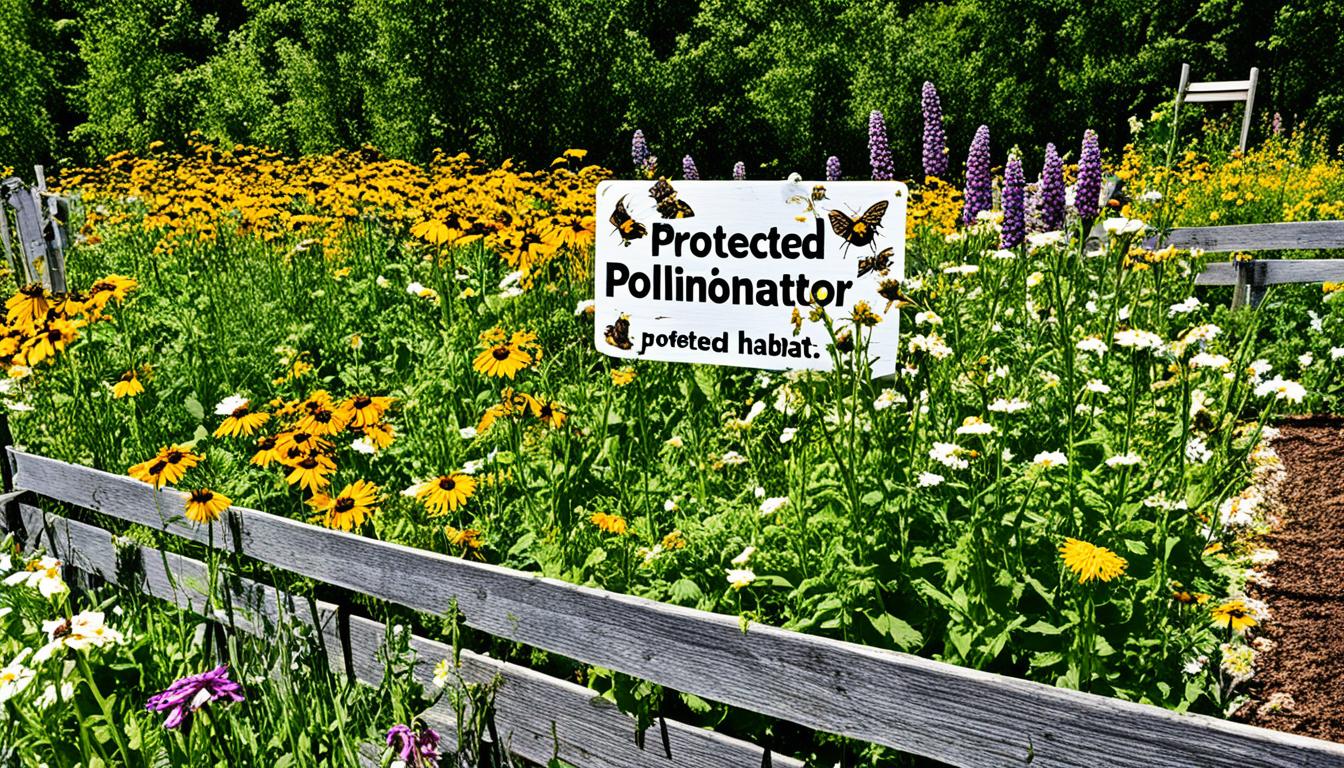
Did you know pollinators help create one-third of the food we eat? This shows how vital they are in making our food and keeping the ecosystem balanced. But sadly, their numbers are dropping fast because of pollution and lost habitats.
The Butterfly Pavilion leads the PACE initiative to help. They focus on making more homes for pollinators, teaching others about their importance, and even getting the community to help track their numbers. By planting local flowers, making water available, and using fewer pesticides, anyone can aid in saving these insects.
The National Seed Strategy also joins the fight. It works with many groups to make sure there are enough seeds to grow places where pollinators can thrive. Projects like these show how important teamwork is in protecting our world.
Furthermore, the Partners for Fish and Wildlife program steps up by helping landowners make better spaces for pollinators and other animals. These efforts are key in keeping nature diverse and healthy.
Pollinators are key in keeping our ecosystems strong and our food supply safe. More than 85% of the world’s flowering plants need them to make new plants. They play a big part in keeping different life forms, including us, going.
Bees are a big deal for making food. They help more than two-thirds of crop plants grow. In the U.S., over 100 crops need their help. Thanks to bees, we get fresh, tasty fruits, veggies, and nuts. This business is worth about $3 billion every year.
Some foods like blueberries and cherries love honey bee help—about 90% of it. Honey bees work really hard, visiting millions of flowers for just a pint of honey. They are vital for our food, showing why saving bees is so important.
Pollinators do more than just make food. They help many plant species grow. This helps other animals find food too. 25% of bird kinds and many mammals rely on plants grown by pollinators.
Groups like Xerces Society work hard to protect bees. Programs such as Bee City USA help cities make safe spaces for pollinators. This makes our home for all animals better, keeping our world in balance.
We need to look after pollinators. Knowing how important they are for food and nature helps us help them. Let’s do our part to make sure they can keep doing their jobs well.
Over the last 25 years, many bees and other pollinators have seen their numbers fall. There are a few main reasons why this is happening. These issues are not only affecting the pollinators. They are also putting our ecosystems at risk.
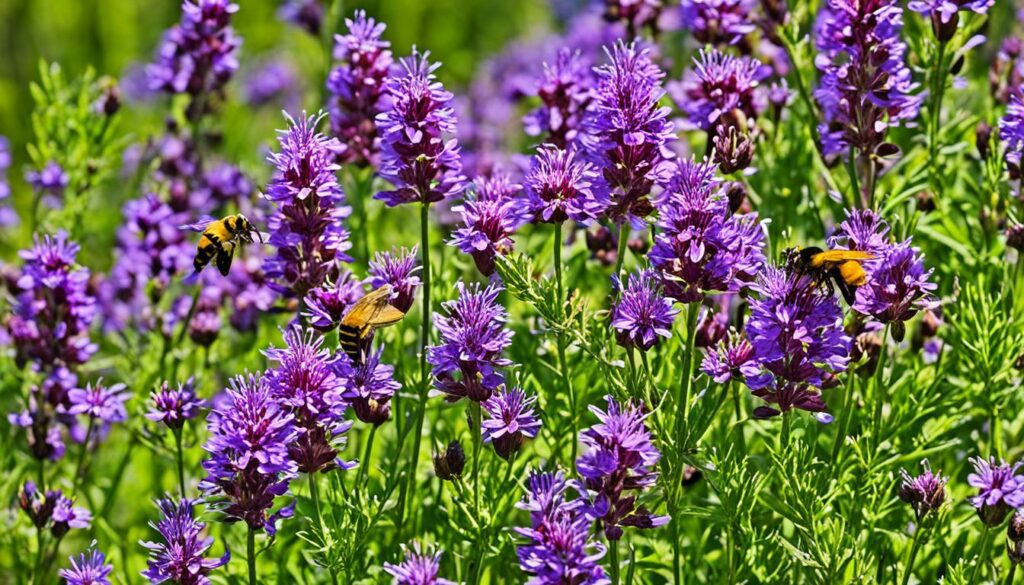
Habitat destruction is a big issue. It takes away the space pollinators need for food and to make homes. Natural areas are being lost to things like roads and gardens. This makes life hard for pollinators. Another problem is pesticide use. This must be reduced quickly to help the pollinators and the plants they help grow.
Climate change is making things worse. It’s causing flowers to bloom earlier. To some pollinators, this means they miss out on much-needed food. Invasive plants are also taking over, leaving less food and shelter for our pollinators. Diseases, often spread because of poor diets and pesticides, are hurting them too.
Pollinator loss is not just their problem. It’s a worry for whole ecosystems. They play a crucial role in plant reproduction. Less pollinators mean less healthy ecosystems. For example, in the United States, the number of honey bee colonies has dropped by half since the 1940s. This is bad news for the various habitats that rely on them.
Migratory pollinators are in even bigger trouble. They struggle to find good spots to stop during their journeys. Sometimes, the distances between these spots are too far, leading to deaths among the weaker ones. This all shows we need to protect our ecosystems better. It’s really important to start using sustainable methods and use fewer pesticides.
| Key Pollinator Declines | Impacts |
|---|---|
| Population decline over 25 years | Destabilisation of ecosystems |
| 50% fall in North American bumblebees since 1974 | Reduced plant reproduction, ecosystem instability |
| 70 species listed as endangered or threatened | Threat to biodiversity |
| Early blooming due to climate change | Limited feeding opportunities |
| Habitat loss and invasion by non-native species | Reduced food, nesting sites |
| Improper pesticide use | Harm to pollinators, ecosystem |
I care deeply about helping pollinators find what they need. This means giving them flowers, safe places to stay, and spots to build nests. It’s vital to avoid using harmful pesticides. We must all work together. By planting local flowers and making paths for wildlife, we help them tremendously.
Farmers and food companies play a big part in saving our pollinators. Working with Bee Better Certified®, they aim to protect bees and other important pollinators. They focus on making places where these insects can thrive, without using too many chemicals.
It’s important to create safe spaces for these insects to nest. Many native bees need certain kinds of ground to lay their eggs in. The Pollinator Protection Pledge suggests ways to help. This includes planting flowers these insects love, making places for them to live, and teaching others about their importance.
The Xerces Society does a lot to help save pollinators. They share important info and do a lot of scientific work. Supporting groups like this with your membership or a donation means they can keep helping out. We urgently need to protect these creatures. In many places, the number of bees and butterflies is dropping fast.
Climate change and farming can be tough on pollinators. But, more and more farmers are joining in to help. They’re planting places for pollinators to live and using farming methods that are safer for them. There’s also a push to get rid of dangerous pesticides. This includes the harmful neonicotinoids.
We need to talk more about all pollinators, not just the well-known ones. Planting local flowers really helps. And so does taking part in science projects and avoiding harmful chemicals. These small steps add up to a lot of help.
Did you know, around 75% of plants need pollinators to grow? From our back gardens to big farms, these insects are very important. We can help by growing plants that bloom from early spring to late autumn. Providing places for them to rest and water for birds and bees also supports this cause.
Getting the community involved and teaching people is crucial. For example, promoting native plants in our own neighbourhood helps a lot. This work brings us all together to benefit our environment for the future.
Making a pollinator garden at home is key for the ecosystem and biodiversity. By using sustainable farming practices and cutting down on pesticides, you’ll help essential pollinators thrive.
Native plants are crucial for pollinator gardens. They offer needed food for bees such as bumble bees, honey bees, and more. These plants are also low-maintenance because they return every year. It’s smart to pick flowers that bloom at different times. This ensures a year-round supply of nectar for pollinators.
A good pollinator garden needs water. Add shallow dishes with stones for safety. This way, pollinators can drink without the risk of drowning.
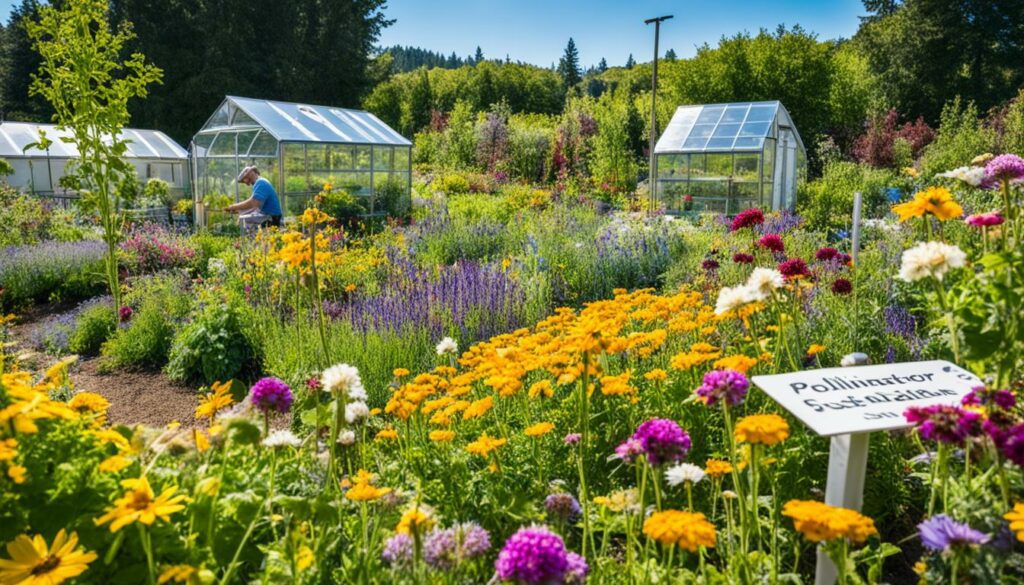
Shelter and nest sites are critical for pollinators. Let natural debris like leaves and branches stay for butterflies and moths. Use bee hotels for bees that need special spots. These steps follow sustainable farming practices and help reduce pesticide use.
Here are some tips to think about:
A designed pollinator garden helps the environment and species important for food supply. Because pollinators are facing a decrease, helping them recover is crucial.
It’s vital to keep bee numbers high for healthy and sustainable ecosystems. We need to welcome many bee types and provide places they can live. This helps them grow and keeps our planet flourishing.
Honey bees, bumblebees, and solitary bees are all very important for our world. They help in pollination, making sure plants can grow. By working with farmers, we can save these precious pollinators.
Programmes like Bee City USA and Bee Campus USA help too. They make sure bees have safe places to live and limit harmful chemicals. The Xerces Society also joins in, spreading the word on protecting where bees live.
Bee hotels are great for solitary bee populations. They give bees a place to nest that’s like their natural homes. Adding open ground and not too many plants around can also help.
Creating small water sources, like a puddle, makes a big difference too. The Environmental Quality Incentives Program (EQIP) and the Urban Pollination Project support these ideas. They aim to help keep habitats good for pollinators. This work is crucial for wildlife and our planet.
It’s vital to lessen how much pesticides harm our environment. They can be dangerous to honey bees and other pollinators. These creatures are key for pollination. They can die if they touch the insecticides or take back contaminated pollen or nectar to their homes. One big sign of pesticide poisoning is finding many dead bees in front of their hives and seeing a sudden drop in the number of bees out working the fields.
For better safety, it’s best to use pesticides in the evening when it’s warm enough. This helps lower the number of bees that die because of them. It’s also wise to pick pesticides that aren’t very toxic and disappear quickly. This way, they won’t hurt bees when they’re out working after a few hours. Using the right forms of pesticides, like solutions or granules, can also make them safer for bees.
Using pesticides from planes is very risky, especially if it’s windy. It’s crucial to not spray them where there are flowers or where bees are working. Also, it’s a good idea to keep beehives at least 4 miles away from fields where harmful pesticides are used.
We need to teach people who garden or farm how to use less chemicals. This education is key in protecting bees and the environment. It focuses on needing fewer pesticides and being very careful when applying them.
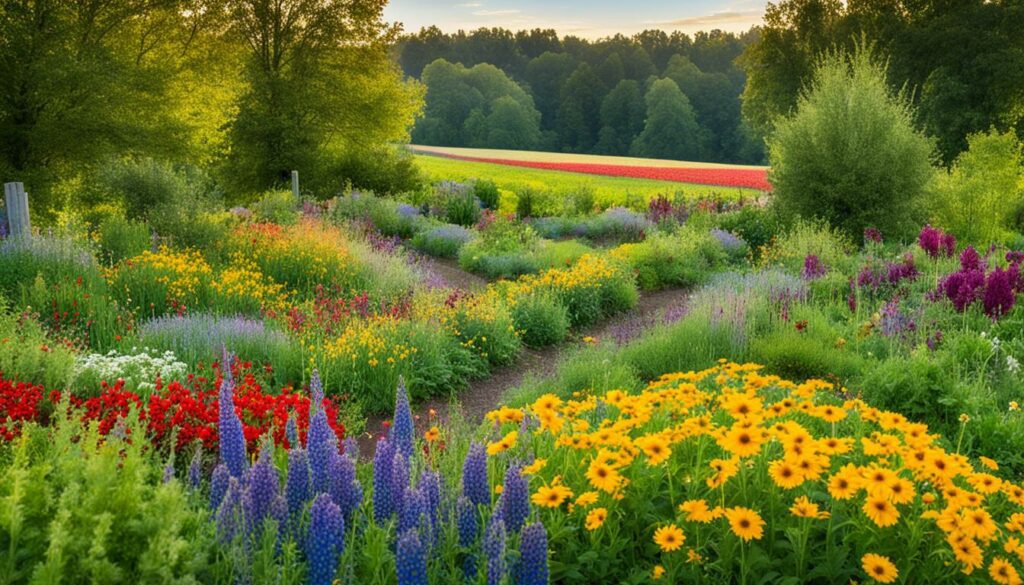
To help bees poisoned by pesticides, we need to do a few things. This includes cleaning or getting rid of contaminated parts of their hives. We should also feed them with safe food like sugar syrup and pollen and move them to places with plenty of natural, safe food. More than 90% of pollen found in bee hives near farms has many types of pesticides. And around the same amount of water samples have these harmful chemicals too.
Bee poisoning can happen in a few ways. Bees can touch the sprays, eat messed up pollen and nectar, or live in infected homes. Neonicotinoids are one kind of pesticide that’s very risky for bees. These are common in both farming and cities. The need for farming that respects nature is clear. We must act fast to save our ecosystems.
Native plants are crucial for supporting life on our planet. They help biodiversity thrive and protect the homes of important pollinators. Native plants are well-suited to the local weather. This means they need less help to grow, like watering and keeping pests away. They are key for making ecosystems that help bees, butterflies, and other pollinators.
Native plants are more than just tough, they are perfect food for local pollinators. Most of the world’s flowering plants need help from pollinators to make new plants. This includes a lot of our food. In the US, pollinators help over 100 crops, adding up to a huge $3 billion a year to the economy.
About 25% of birds and many mammals rely on fruits and seeds made through insect pollination. This shows how important native plants are for a lot of animals.
Choosing the right native plants for your area can greatly help biodiversity. You can find good matches by looking at local plant guides and thinking about what local pollinators need. For example, Bee Better Certified® encourages the use of native plants in farming. This is good for the environment and the crops.
Initiatives like Bee City USA and Bee Campus USA work to create places better for pollinators. They push for using fewer pesticides and for adding lots of native plants to these places.
North Carolina is a great example of how using native plants can do a lot of good. The state has three main areas that are home to many different animals and plants. Though, many of these important species are in danger because their homes are shrinking.
By planting native plants, we not only help these species but also keep the environment in balance. This is important work for us and for the future of our world.
| Pollinator Service | Impact |
|---|---|
| Reproduction of Flowering Plants | 85% of flowering plants require pollinators |
| Global Crop Species | Two-thirds depend on pollinators |
| Economic Value in the U.S. | $3 billion per year |
| Wildlife Dependence | 25% of birds and mammals |
Sustainable farming practices help protect pollinators’ homes. They also ensure our farms will keep producing food for the future. These ways make our environment stronger and let us use fewer chemicals.
Integrated Pest Management is an all-around method to keep pests away. It uses fewer chemical sprays by using nature’s own pest controls. Strategies like using helpful insects and choosing plants that bugs don’t like help keep pests in check. Since bees don’t go far to find food, we protect where they live by using fewer poisons close to their nests.
Agroforestry mixes trees and bushes with crops, making farms more like natural spaces. It provides homes for pollinators, like native bees, which are key for much of our food. These mixes help wildlife and cut down on the need for chemicals by using nature to control pests.
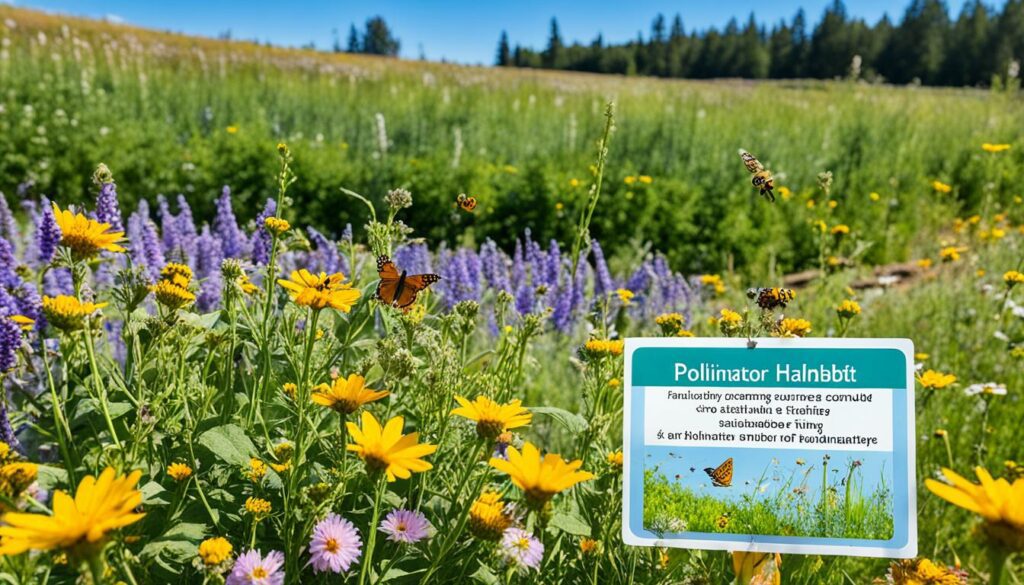
| Practices | Benefits |
|---|---|
| Integrated Pest Management (IPM) | Reduces pesticide use, maintains pollinator safety, and promotes sustainable pest management. |
| Agroforestry Systems | Enhances biodiversity, provides shelter for pollinators, and decreases reliance on chemical pesticides. |
| Creating Bee Habitats | Increases crop yields, supports wild bee populations, and contributes to economic benefits. |
Wildlife corridors help keep ecosystems healthy by letting animals move safely between areas. They are vital for the survival of native plants and making ecosystems stronger.
In 2019, $2.1 million was given for creating pathways for elk, mule deer, and pronghorn to move in Western states. This money helped reopen 4,500 miles of streams and 15,000 acres of wetlands, where fish can now travel, too.
Since 2005, Laguna Atascosa and its partners built 14 underpasses for ocelots, making it safer for them to move. In 2021, Tualatin River Refuge removed a road barrier. Now fish in Chicken Creek can swim freely, helping their populations.
Monarch butterflies fly thousands of miles and use corridors to find food. Studies in the Kanuti Refuge show how important these pathways are for different animals. They need these corridors for survival.
Many bumblebees and butterflies are in danger. One way to help them is to create special paths for them. Even roadsides can become safe spaces for them. Doing this reduces risks like too much mowing, which harms butterflies.
| Initiative | Details |
|---|---|
| DOI Grants (2019) | $2.1 million allocated for habitat corridor conservation |
| U.S. Fish and Wildlife Service Efforts | Reopened 4,500 stream miles and 15,000 acres of wetland habitat |
| Laguna Atascosa Refuge | Built 14 road underpasses for ocelots since 2005 |
| Tualatin River Refuge | Removed centre dike road for fish passage in 2021 |
| Monarch Butterfly Migration | 3,000 miles migration between Mexico and California |
| Canada Lynx Study | Geospatial technology used in Kanuti National Wildlife Refuge |
Creating wildlife corridors is key to keeping nature balanced. They help plants, pollinators, and other creatures. By doing so, we help protect our environment.
Adding flowering plants wisely is key to helping pollinators. It’s important to have a range that blooms all year long. This helps keep the habitats safe for pollinators and aids in saving ecosystems. Our efforts ensure bees and butterflies always have food.
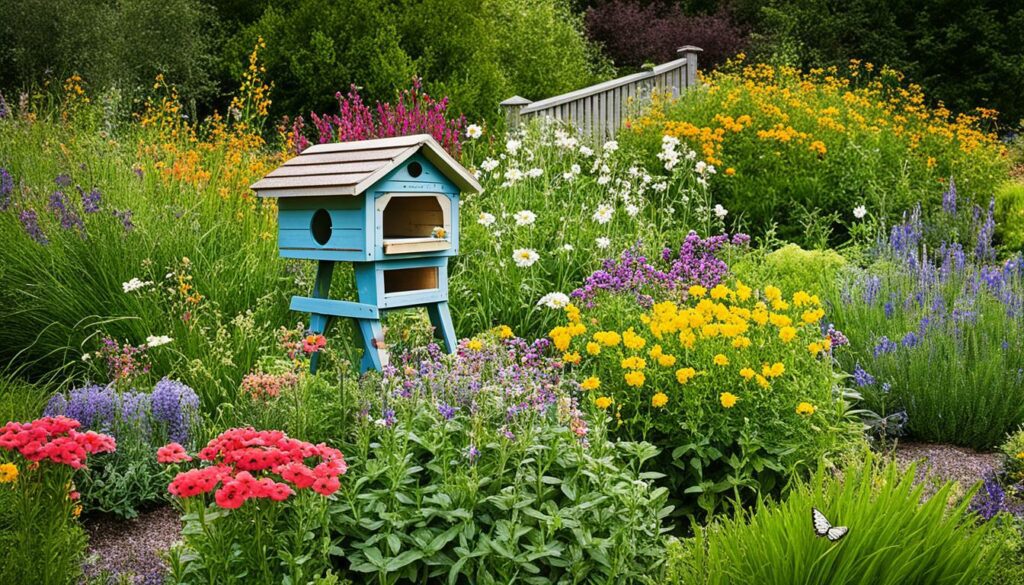
A mix of plants that bees and butterflies like is essential. You should choose plants that are good for your area. For example, the Michigan State University website has great advice. It recommends using the scientific names of the plants. This helps make sure they attract bees.
Planting flowers in groups is another good idea. It makes the food show up better, catching pollinators’ eyes. This means they can find food faster. Taking good care of these plants by pruning helps keep the food coming.
| Pollinator-Friendly Plant | Season of Bloom | Type of Pollinator |
|---|---|---|
| Aster (Aster spp.) | Autumn | Bees, Butterflies |
| Milkweed (Asclepias spp.) | Summer | Bees, Butterflies |
| Coneflower (Echinacea spp.) | Summer | Bees, Butterflies |
Taking good care of these plants makes a big difference. It helps keep pollinators around. This is crucial for the health of our ecosystems.
It’s key to know where to plant for pollinators, helping local plants thrive. They might seem small but pollinators are crucial. They help 85% of the world’s flowering plants reproduce. In the US, they add around $3 billion each year to farming and help over 100 crops grow.
Choosing the right plants is vital for pollinator areas to flourish. This ensures they can easily move around. It also keeps their numbers up and helps the environment stay balanced. Native plants, like Lavender and Coneflower, give pollinators the food and shelter they need.
Many groups are here to guide us in this work. The Xerces Society offers help with plant lists and habitat guides. Also, programmes such as Bee Better Certified®, Bee City USA, and Bee Campus USA help make our farms and towns better places for pollinators.
This table shows why we must protect pollinators and what they do:
| Statistic | Impact |
|---|---|
| 85% of the world’s flowering plants rely on pollinators | Supports plant reproduction and biodiversity |
| Pollinators’ economic value in the U.S. ($3 billion/year) | Critical for agriculture and food production |
| Over 100 U.S. crops require or benefit from pollinators | Ensures food security and variety |
| 25% birds consume fruits/seeds from insect pollination | Maintains bird populations and ecosystems |
By learning about and helping pollinators, we protect more than just insects. We keep the life around us healthy. Creating green paths and planting the right natural species help our world be strong and full of different life.
Helping biodiversity and looking after pollinators’ homes is key to feeding pollinators. It’s very important to give them places to shelter and build nests.
Pollinators need things from nature and things we make to do well. Bees, for example, like to nest in different kinds of places.
Keeping things like dead wood and parts of the ground clear can help give them these important spaces.
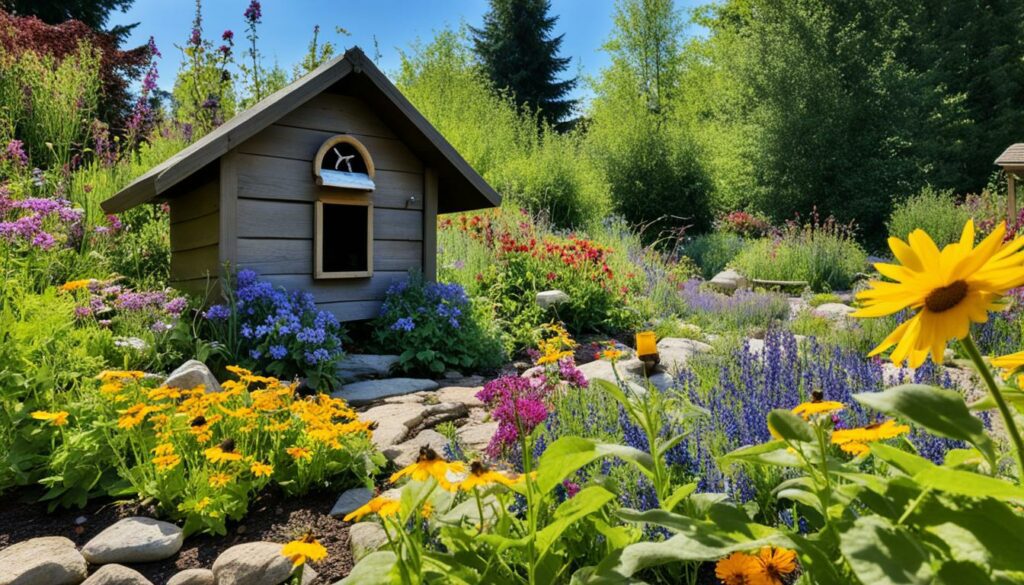
There are many ways to make homes that insects like:
These special places for insects also make the world more full of different kinds of life. They keep pollinators’ homes safe too.
| Pollinator Species | Nesting Preference |
|---|---|
| Ground-Nesting Bees | Burrows just beneath the surface |
| Cavity-Nesting Bees | Beetle holes in dead wood, hollow stems |
| Bumble Bees | Underground, hollow trees, abandoned nests |
Community involvement is key in protecting pollinators and their ecosystems. Local efforts and educational schemes are crucial. They bring people together to tackle the challenges these important species are facing.
Bee City USA and Bee Campus USA show how locals can help pollinators. They promote eco-friendly farming and reduce the use of harmful pesticides. This makes our environment better for everyone. Bee City USA has over 300 affiliates in 45 states and D.C., making a big impact.
Each year, Bee City affiliates help create thousands of acres of new pollinator-friendly spaces. Even small actions, like Appleton’s No Mow May, can make a big difference. Here, over 400 people helped pollinators just by not mowing their lawns. Projects by groups such as Pheasants Forever and Quail Forever are proof that community work turns into the real conservation of ecosystems.
Teaching others about pollinators is vital. Programs that share why pollinators are important and what dangers they face are critical. Look at the Pollinator Protection Pledge. It shows how everyone can help by growing the right plants, providing homes, and avoiding harmful chemicals.
Working with groups like the Association of Zoos and Aquariums helps spread the word. This then gets more people involved in butterfly protection efforts. Also, the Partners for Fish and Wildlife program assists landowners. They want to make better homes for pollinators. Together, they show how teaching and offering help can truly save our pollinators.
We must protect pollinators’ homes and safeguard nature. Innovation, tech advances, and strong policies are leading the charge in this fight. These new solutions are helping protect our valuable pollinators.
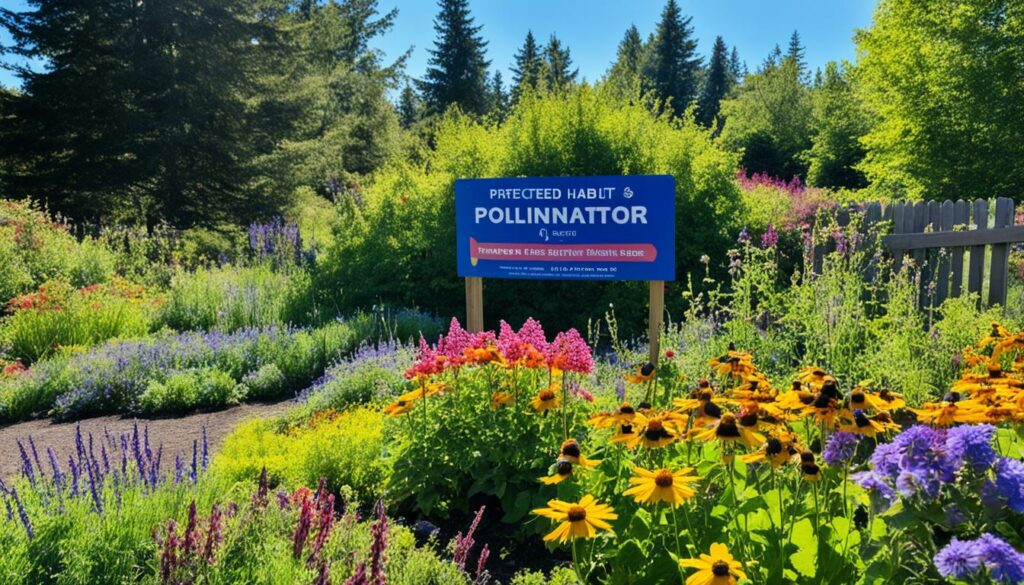
Tech is key in protecting where pollinators live. It lets us watch where they go and how their homes are doing in real-time. With drones and sensors, we can fix up these places exactly right, making conservation efforts better.
Superfund sites in the US have turned from polluted to perfect for pollinators. Chemical Commodities and Palmerton Zinc Pile are good examples. They’ve become lively places for bees and butterflies thanks to smart tech use.
| Pollinator Habitat Restoration | Technological Implementation | Results |
|---|---|---|
| Chemical Commodities | Drones for precise planting | Increased population of native bees |
| Palmerton Zinc Pile | Remote sensors for soil health | Enhanced biodiversity |
| Bunker Hill Mining | Advanced water systems | Attracted a variety of pollinators |
Setting the right policies is also vital in protecting pollinators. Take the Presidential Memorandum on June 20, 2014. It asked for a hard look at pesticides hurting pollinators and their health. This kind of action helps keep nature safe and supports our pollinators.
Building wildlife paths and making cities more pollinator-friendly is critical too. Many groups push to see these policies put in place and work well. They’re helping ensure a good future for our pollinators.
Pollinators are key to keeping our planet’s plants alive, helping ecosystems thrive and biodiversity bloom. North America boasts about 4,000 kinds of native bees that play a vital role in nature. Yet, managed honey bee hives in the US have dropped by half since 1950, showing us we must safeguard their homes.
In California, where more than 1,000 native bees live, wild bees have boosted honey bees’ pollination work by five times. This has led to around 80 kinds of native bees aiding in the pollination of cranberries in Massachusetts. So, supporting wild bees not only enriches nature but also increases farm harvests. Take bumble bees, for example. With their buzz pollination, they’re better than honey bees at distributing pollen, making them vital for crops like cranberries.
When it comes to our food, bees are literally worth their weight in gold. They help pollinate 71 out of every 100 crops that provide 90% of the world’s food. In the US, farming supported by bee pollination is worth an impressive $20 billion a year. Across the globe, the help of these little pollinators is valued between $235 billion and $577 billion yearly. It’s clear that we need to band together, from individuals to communities, and promote policies that protect these important creatures. This is our best shot at making the planet healthier for those who come after us.
Pollinators are vital for making our food. They are behind a third of the food we eat. By pollinating crops, they help keep our food chain going strong.
Pollinators add to the variety of plants we see. This variety is important for a healthy world. It supports many kinds of plant and animal life.
The main reasons for fewer pollinators are loss of homes and harmful chemicals. Pesticides, bugs, and diseases have hit their numbers hard. This puts our environment at risk.
Less pollinators mean trouble for nature. Many plants need them to reproduce. A drop in their numbers harms the food chain and upsets the balance of life.
Keeping their spaces safe involves planting the right plants and cutting back on pesticides. Letting them live and grow helps protect our environment.
Start by selecting plants that are local. Make sure there is water and places to hide. Be careful with chemicals to keep them happy and healthy.
All bee homes are different. Make sure there are homes for those that live in wood and those in the ground.
Bee hotels are like apartments for bees. They fit into making a home that is good for bees. This helps our environment.
Use smart farming methods that are kind to the land and don’t overuse chemicals. This keeps pollinator homes safe and well.
Plants that grow easily where you live need less help. Using them helps all of the animal life to stay strong and diverse.
Look for plant guides and think about what bugs need. Choosing the right plants makes a home for them.
IPM is a smart way to deal with pests without using too many chemicals. It’s good for both the land and pollinators.
Agroforestry adds trees and bushes to farms, helping pollinators find more places to live. It’s good for the land and insects.
Wildlife paths help bugs travel and find new homes. They are key to keeping pollinator groups healthy and strong.
Plant flowers that bloom all year for a constant food supply for pollinators. Clustering flowers makes it easier for them to find food.
Use plants that belong where you live to create a great home for bugs. This connects local habitats and supports many types of pollinators.
Use natural things, like old wood, for bee homes. Also, leave some ground bare. Making bee boxes is another helpful idea.
The work of many people can make big changes for pollinators. Everyone helping out means a safer environment for all.
New tech and strong rules can make homes for bugs better. It’s important to make sure pollinators are remembered in protecting nature.